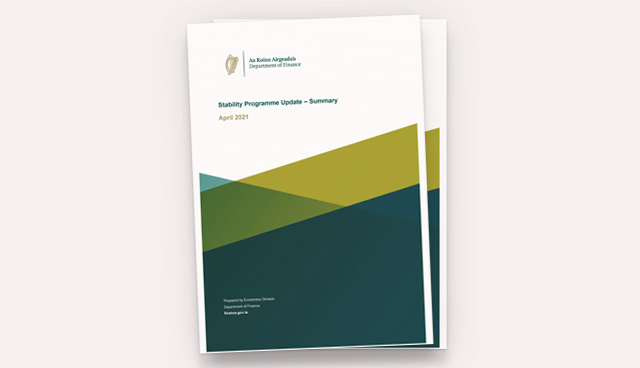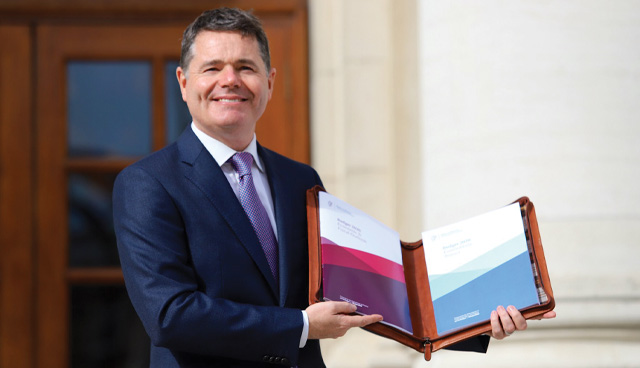Stability Programme Update 2021

As necessitated by European budgetary rules, the Stability Programme Update (SPU 2021) was published by Minister for Finance Paschal Donohoe TD in April 2021 and outlines the Department of Finance’s medium-term (2021 to 2025) macroeconomic and fiscal forecasts.
In the short-term, the Irish economy remains exposed to exogenous factors such as Covid-19, its variants, an initially lethargic delivery of the vaccination programme. However, the programme is now well underway and is anticipated to conclude in the second half of 2021.
As such, SPU 2021 assumes that vaccination deployment targets will be met, and that vaccination will be effective, leading to reopening of the economy from the second half of 2021. As such, it forecasts that GDP will increase by 4.5 per cent in 2021 and 5 per cent in 2022. Beyond 2022, the SPU forecasts that the economic recovery will continue from 2023 to 2025, with spare capacity in the economy reducing in positive correlation.
Overall, resilience of the Irish economy has been determined by those prosperous sectors which are commanded by multinational corporations, such as the pharmaceutical and ICT industries. Domestically, however, exposed consumer-facing sectors, such as retail and hospitality, have underwent significant contraction due to an inability to pivot to remote working. These contrasting experiences of the pandemic have once again emphasised the dual economy that exists in Ireland, explaining Ireland’s relatively strong economic performance in the interim.
Labour market
The pandemic had a significant impact on the labour market, with labour-intensive sectors and young people experiencing greatest job losses. CSO figures for April 2021 indicate that the Covid-19 adjusted unemployment rate was 22.4 per cent. The SPU forecasts that this rate will average 16.3 per cent in 2021 before falling to 8.2 per cent in 2022, modestly continuing its descent thereafter.
Following the relaxation of public health restrictions for consumer-facing sectors, the employment growth rate is expected to be 4 per cent in 2021 and 11 per cent in 2022. Likewise, compensation of employees is projected to grow by 4.1 per cent in 2021 and 4.0 per cent in 2022. This growth rate is lower than in pre-pandemic years, reflecting the likelihood that employment growth will occur in sectors with relatively low pay.
However, one potential scenario is that labour market scarring delays any recovery in employment and contributes to increased long-term employment.
Inflation
In common with other eurozone countries, the Harmonised Index of Consumer Prices (HICP) inflation was recorded at -0.5 per cent in 2020. As the pandemic recedes and the economy recovers, inflation is forecast to increase to 1.1 per cent in 2021 and 1.9 per cent in 2022, higher than in years prior when the inflation rate was less than 1 per cent. Contributing factors to the increased inflation rate include pent-up demand, increased oil prices and the conclusion of the temporary reduction in the standard rate of VAT.
Global economic outlook
Across the world, the vaccination rollout, and expansive fiscal policies in the largest economies, such as the Next Generation EU recovery plan and the American Rescue Plan Act, have improved the global economic outlook. Economic recovery in Ireland as small, open economy will, in part, be determined by the fiscal stimuli in the key trade markets of the EU and the US.
Informed by the rapid deployment of vaccination programmes in the US and the UK, the IMF forecasts robust recovery for both nations in 2021. Meanwhile, the Eurozone economy is expected to experience a comparatively weaker recovery in 2021 ahead of stronger growth in 2022.
Tax revenue
There is a marginal difference between the tax revenue estimate contained in Budget 2021 and that within SPU 2021. The SPU’s estimate projects a total tax revenue of €60.395 billion, a mere €5 million above that of the Budget. Overall, it is estimated that tax revenue in 2021 will increase by 5.6 per cent when compared with 2020. Revenue growth out to 2025 is expected to be propelled primarily by an average 7 per cent annual growth in income tax and VAT receipts from 2022 to 2025.

“We are projecting an improvement in the public finances next year. There are, however, clear downside risks for the public finances. In particular, international corporation tax reform could weigh more heavily on this revenue stream than is currently assumed.
“Having said that, the public finances are in a much better position to absorb the expected shock… The tax base is much wider than prior to the global financial crisis and, importantly, there is time build up the resilience of the public finances before international reforms move to the implementation phase.”
— Minister for Finance Paschal Donohoe TD
VAT recovery is reliant on the extent to which household savings are consumed as society reopens, with the Department estimating that one-fifth of excess savings will be spent from Q3 2021 and throughout 2022. It is anticipated that capacity will constrain this spending, either in terms of speed or extent of overall spending.
Meanwhile, the income tax rebound will be determined by increased employment in those labour-intensive sectors which have been effectively shut since the onset of the pandemic. Therefore, a slow recovery in employment could serve to disrupt income tax receipts recovery. Conversely though, these sectors contribute comparably less to income tax revenue than others, explaining its resilience over the last year.
Most conspicuously, in contrast to significant growth in receipts in the years preceding the pandemic (averaging 13 per cent each year between 2015 and 2019), the corporation tax revenue stream is expected to increase by a mere 5 per cent in the period from 2020 to 2025. Indeed, SPU 2021 estimates project that annual corporation tax receipts could be €2 billion less by 2025 as a result of international tax reform.
Spending
Over one decade, the SPU projects that total gross voted expenditure will increase from around €55 billion in 2015 to almost €87 billion in 2025. Prior to the pandemic, total gross voted expenditure for 2020 was €70.4 billion. In reality, gross voted expenditure was €14.9 billion higher, totalling €85.3 billion. Meanwhile, ‘core spending’ (excluding Covid- and Brexit-related spending) is anticipated to grow by an average of 3.5 per cent between 2022 and 2025.
Short-term
Budget 2021 capped the Government Expenditure Ceiling at €87.8 billion. SPU 2021 did not revise this projected voted spending but did indicate that a contingency of €5.4 billion of non-allocated funds would be spent.
In Q1 and Q2 of 2021, spending pressures, such as pandemic supports (totalling €3.3 billion in Q2 alone), were sustained by the extension of public health restrictions.
As per government policy, the SPU assumes that the Pandemic Unemployment Payment and the Employee Wage Subsidy Scheme would cease on 30 June 2021. However, extended deadlines of 7 September 2021 and 31 December 2021 respectively have now been confirmed and are likely to deplete the €5.4 billion contingency. As such, to allocate these funds, new revised estimates or supplementary estimates will be required across several votes. Given this context, it is also possible that voted expenditure could exceed the government expenditure ceiling.
Medium-term
For its ‘core spending’ projections from 2022 to 2025, the SPU assumes a 3.5 per cent growth rate of expenditure. While this is higher than assumed spending growth contained in its predecessors (voted spending grew at 5.9 per cent per annum between 2015 and 2019) meaning that SPU 2021’s assumptions can be regarded as conservative.
In both 2023 and 2024, spending is estimated to be €3.5 billion more than in Budget 2020. From 2020 to 2025, gross voted expenditure is expected to be a cumulative total of €42.5 billion higher than in Budget 2020.
Outlining non-core expenditure of €2.5 billion for Covid-related spending and €1.5 billion for ‘automatic stabilisers’ in instances of higher unemployment in 2022, the SPU indicates that this is expected to decrease as the economy recovers in the years beyond.

“Today was an opportunity to put forward a credible and ambitious plan to address the challenges we faced before this pandemic, and that have been exacerbated by it. To end the housing crisis created by Fine Gael, to ensure that our children no longer sit in the most crowded classrooms in Europe, to tackle a decade of underinvestment and mismanagement in our hospitals by successive governments.
To take advantage of the low cost of debt-financing in order to invest in infrastructure across the country, boosting regional development and an inclusive recovery. “Today’s report failed to provide that ambition, with no credible path of how the Government can deliver on the needs of workers and families over the next five years.”
— Sinn Féin spokesperson on finance Pearse Doherty TD
Similarly, EU funds, including the Brexit Adjustment Reserve (€1.1 billion in 2022) and the Recovery and Resilience fund (€800 million from 2022 to 2024) are anticipated to be absorbed by capital expenditure and are, therefore, considered to be non-core.
Parliamentary Budget Office (PBO) analysis suggests that the SPU’s scant detail in expenditure is only partially masked by its technical spending scenario. As such, it breaches the spirit of spending reforms such as ministerial expenditure ceilings and the Spending Review.
“There is no indication of what spending is needed to ‘stand still’ i.e. maintain public services at their current level and thus what funds are available for new policies. There is little analysis of medium-term spending pressures or costing of new policies. Without such analysis the spending figures lack a degree of credibility,” the PBO concluded.
Spending risks identified in the SPU as being medium- and high-likelihood are: Covid-related budgetary pressures; an ageing population; EU budget contributions; litigation risk; and climate action targets.
Government debt
Contrary to Budget 2021, the SPU has revised General Government Revenue (GGR) up by 2.1 per cent, while General Government Expenditure (GGE) has been revised down by 0.6 per cent, narrowing the estimated deficit by €2.4 billion to €18.1 billion or 4.7 per cent of GDP for 2021.
Beyond 2021, GGR is projected to increase by 7.4 per cent in 2021 and grow by an average of 4.5 per cent between 2022 and 2025. Meanwhile, as Covid supports come to an end, GGE is anticipated to decrease by 2.6 per cent in 2022 and 0.9 per cent in 2023.
While additional stimulus measures could be introduced to mitigate potential scarring, the SPU’s estimates assume no policy change. If introduced, such measures could increase the deficit relative to baseline estimates. However, unlike in Budget 2021, alternative ‘downside’ scenario estimates have not been included in the SPU.
The SPU projects that Ireland’s gross General Government Debt (GGD) will be 2.8 per cent of GDP in 2022 (€11.5 billion), 0.2 per cent below the deficit threshold established in EU fiscal rules, which are currently suspended. If this GGB projection is realised, Ireland could avoid triggering an excessive deficit procedure when the suspension ends.
In 2020, the public spending increases required to mitigate the pandemic culminated in increased government debt. This increase is expected to continue out to 2025.
While uncertainty shrouds the actual deficit for 2021, the SPU estimates a €20.7 billion increase in 2021 followed by an €8.1 billion increase in 2022. Public indebtedness is projected to total €262.9 billion by 2025, a significant increase on the figure of €204.2 billion in 2019. This would position Ireland’s debt-income ratio among the highest in the developed world.
However, Debt-to-GNI*, a key metric of debt sustainability, is forecast to decrease from 111.8 per cent of GNI* (€293.3 billion) in 2021 to 100 per cent in 2025. Amid strong growth projections and low borrowing costs, the additional debt can be regarded as ‘sustainable’. Additionally, the PBO contends that “fiscal consolidation may not be required to ensure that the debt burden is on a sustainable path” because of the long-term maturity profile and fixed rates of a significant portion of Irish debt.
Post-pandemic, “a prioritisation of growth enhancing measures” should place the debt burden on a sustainable trajectory over the coming decade. While the current debt burden can be interpreted as sustainable, the additional debt could restrict fiscal flexibility in the event of another economic shock requiring significant government borrowing.





